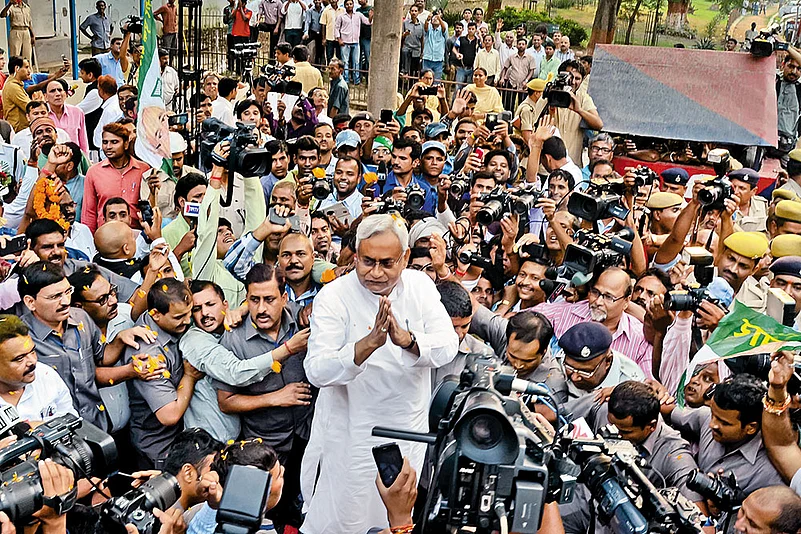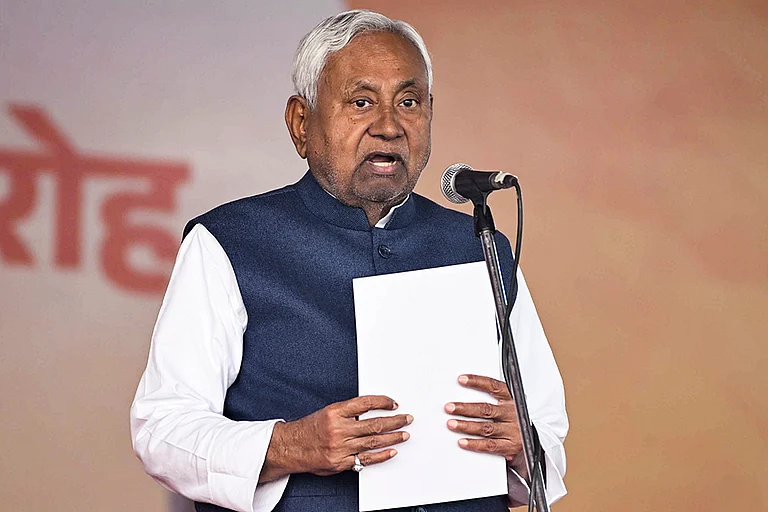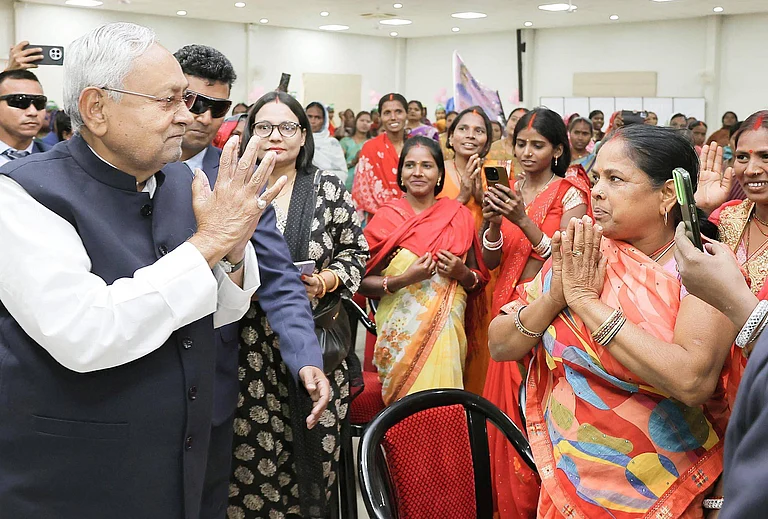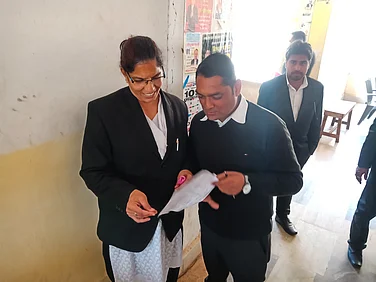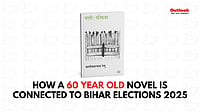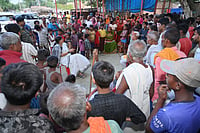
Nitish began his political journey in the 1970s through student politics while studying electrical engineering at the Bihar College of Engineering under Patna University.
Nitish and Lalu had shared a long political friendship, but once Lalu came to power, Nitish found himself pushed to the margins.
Despite persistent reports of declining health and speculation that his political run was nearing conclusion— including rumours of a JD(U) split—Nitish recently staged a notable electoral recovery in 2025.
Despite the scale of the victory, the Janata Dal (United) office on Veerchand Patel Road in Patna wore a subdued look on the evening of November 14. The headquarters sits barely a kilometre-and-a-half from the state Secretariat, but the trickle of supporters made it feel like any other night in Patna rather than the end of a hard-fought election.
Those who had gathered were jubilant but careful. Faces were streaked with pink and green gulaal (celebratory coloured powder) and two groups of supporters danced in the courtyard while a handful of hired artists kept up a steady beat on the tasha (single-headed drum) and drums. In the middle of it all, 65-year-old Om Prakash Singh danced without pause until exhaustion forced him to sit under a nearby tree. “Shareer thak gaya, lekin mann nahi bhar raha hai” (The body feels tired, but the mind wants more), he said between breaths. Singh had arrived at the JD(U) office in the afternoon from Saran district, travelling 70 kilometres, when the election results were almost clear.
He belongs to the Awadhia Kurmi caste listed under Other Backward Class (OBC) and is a die-hard fan of Nitish Kumar, who is also an Awadhia Kurmi linked to the lineage of Raghuvanshi Kshatriya of Awadh. Singh says Nitish transformed society and empowered women and that is why he won big today too.
Many supporters came to the party office to see Nitish but were disappointed, as the 74-year-old neither came nor addressed the public and even his celebratory photo did not appear.
Nitish’s close associates say that over time he has become self-contained and avoids celebrations. “He is oversatisfied with what he has done for the people of Bihar and thinks about why he would celebrate the victory. He is above petty politics,” says Saryu Roy, his associate and star campaigner.

From Engineering to Politics
Born into a political family in Kalyanbigha village of Nalanda district in 1951, Nitish was drawn to politics while studying in Patna. His father, Ram Lakhan Singh, was a politician and ayurveda practitioner. Singh had been associated with the Congress but left politics in frustration after being denied a ticket and returned to selling ayurvedic medicines in Bakhtiyarpur, where he later settled.
Nitish began his political journey in the 1970s through student politics while studying electrical engineering at the Bihar College of Engineering under Patna University.
It is believed that he was also deeply upset by his father’s denial of a Congress ticket. When he entered student politics, he embraced the socialist ideology, which was opposed to the Congress at the time.

During his student years he grew close to Lalu Yadav, who had won the Patna University Students’ Union election in 1973 and become general secretary of the student body. Lalu later became head of the Chhatra Sangharsh Samiti—linked to Jayaprakash Narayan’s non-cooperation movement. It is said that when Shivanand Tiwari who was an active participant in the movement was arrested, Nitish was nominated in his place, which brought Lalu and Nitish closer.
When Indira Gandhi imposed the Emergency in July 1975, Nitish went underground to avoid arrest. He was arrested in June 1976 and remained in jail for nine months before being released in March 1977. That year, the Janata Party gave him a ticket from Harnaut in the Bihar assembly elections. In May 1977, Kurmis murdered eight Dalits and three OBCs in Belcchi village over a land dispute. The massacre changed the caste equation in Harnaut, which had a significant Kurmi population and Kurmis were willing to support candidates who took the side of those accused in Belchhi.
Nitish lost this election to Bhola Prasad Singh, an influential Kurmi leader. He contested again from Harnaut and lost a second time. These defeats shook him and he even considered quitting politics and working as a contractor. He decided to try once more, and, in the 1985 assembly elections, contested from Harnaut for a third time on a Lok Dal ticket and won, amid accusations of electoral malpractices. The win revived his career. In the 1989 Lok Sabha elections, he won the Barh seat and went on to become a Union Minister of State.

Nitish and Lalu had shared a long political friendship, but once Lalu came to power, Nitish found himself pushed to the margins. He was left unsure of how to shape his own political journey or which voters he could reliably call his own.
When Lalu eventually became chief minister, he implemented job reservation based on the Mandal Commission’s recommendations, which the Supreme Court endorsed in 1992. As Yadavs were the largest OBC group, non-Yadav OBCs such as Kurmis and Koiris feared being edged out.
Veteran journalist Ganga Prasad says, “Actually Nitish Kumar wanted to implement former chief minister Karpoori Thakur’s reservation formula, which gives more reservation to the extremely backward class, but Lalu had implemented a reservation which gave more reservation to OBC. That became the trigger point of Nitish parting ways from Lalu.”
In 1994 fourteen MPs, including Nitish, broke from the Janata Party and formed the Janata Party (George), which later became the Samata Party. The new party contested the 1995 assembly elections, winning only seven of the 310 seats it fought. With the BJP gaining strength and the Samata Party drawing mainly from Kurmi and Kushwaha votes, which together made up only seven per cent of the state’s voters, the party formed an alliance with the BJP. The Samata Party was later renamed JD(U) and came to power in November 2005.
Women-Centric Schemes
Just two months after coming to power, Nitish cleared a cabinet decision granting 50 per cent reservation to women and 20 per cent to Extremely Backward Classes in three-tier panchayats.
In 2006 he was at an official programme in Patna where he distributed a few cycles to underprivileged children and first got the idea for a cycle scheme for girls. “When I handed over the keys to them, I could see happiness all over their faces. The memories of those happy faces of poor children remained with me long after the ceremony was over,” he recalled in a 2010 blog. He then met state Human Resource Department officials and asked them to prepare a scheme to distribute free bicycles to all high school girls. The cycle scheme began in this way and became an instant hit.
By 2015, political expediency dictated an alliance: Nitish partnered with Lalu’s RJD to form the Mahagathbandhan, defeating the BJP in the assembly polls.
He wrote in his blog, “I always believed that any society cannot progress unless its women progress and the women in any society cannot progress unless they are educated.”
That belief also shaped his politics. As he pushed these ideas in policy, he was also aware that women across caste and class could become a quiet but dependable vote base.
In the years that followed, Nitish introduced several women-centric schemes. In 2021 he announced a 33 per cent horizontal reservation for women in state engineering and medical colleges and in July this year he announced a 35 per cent reservation for women in all government jobs.
He also launched the World Bank-aided Bihar Rural Livelihoods Project with the Bihar Rural Livelihoods Promotion Society under the Department of Rural Development. Known locally as JEEViKA, the project aims at social and economic empowerment of the rural poor. So far, 11.07 lakh self-help groups have been formed in 34955 villages under its aegis.
Days before polling, he announced the controversial Mahila Rozgar Yojana, which offers monetary help of up to Rs. 2 lakh to aspiring businesswomen. The first loan instalments of Rs. 10,000 were transferred to the accounts of 75 lakh women on September 26 by the Prime Minister and another 21 lakh women on October 6. During the campaign Nitish said publicly that women would not need to return the money.
Nitish is not a charismatic leader like his former friend-turned-foe Lalu, yet he remains relevant in Bihar politics, begging the question, what made him such an enduring figure?
Ganga Prasad says, “Nitish Kumar is a serious leader and he has sophistication in his behaviour. But he is not a people’s leader like Lalu Prasad... Nitish is an expert in the politics of jod tod (political manoeuvring) and that is what made him still relevant. Additionally, he implemented many schemes for women, extremely backward classes and Dalits, which helped him to create a dedicated vote bank.”
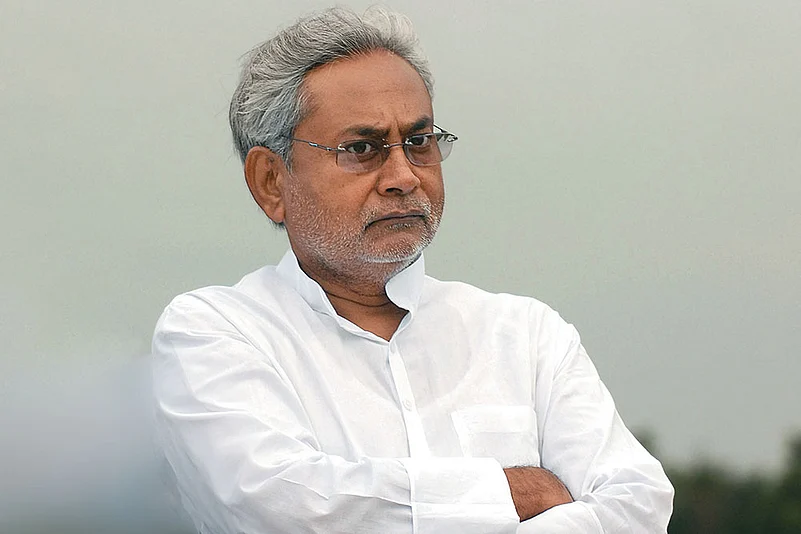
Former Rajya Sabha MP Shivanand Tiwari, who had a decades-long association with both Nitish and Lalu, wrote in a Facebook post on Novemebr 17, 2025, “Nitish Kumar is a weak man at heart. He has never taken a risk in his life. That is why he remained confined to Bihar.”
Subhashini Ali offered a critical assessment of Nitish’s record on women’s empowerment, despite recognising his progressive stance in other areas.
Ali, a former Member of Parliament, recalled the time when they were both MPs, stating, “I found him a progressive man when we were in parliament as MPs, but for women’s empowerment, he didn’t do much.”
She highlighted the plight of women caught in the debt cycle of micro-finance, adding, “Women are trapped in micro-finance, but the government has not taken any action against people running micro-finance companies.” Furthermore, she lamented the lack of economic opportunities: “He did not give employment opportunities to women. Migration is rampant.”
Ali then addressed the electoral impact of direct cash transfers, attributing significant vote share to a Rs. 10,000 credit to women’s bank accounts, which she argues reveals the depth of their poverty. She explained the significance of the sum to the recipients: “Women are so poor and helpless that immediately having Rs. 10,000 credited to their bank account was certainly a big deal for them. Many voted for him because they got Rs. 10,000 and many votes, as they were hoping for a chance to get it. This reflects their acute poverty.”
Love-Hate Relation with Narendra Modi
A recent and unsettling shift in political etiquette was observed as Nitish, the veteran leader and once-presumed prime ministerial aspirant, was seen attempting to touch the feet of Prime Minister Narendra Modi. The gesture, directed at a colleague only eight months his senior, was instantly noted by seasoned political observers, given their history as arch-rivals.
As Chief Minister, Nitish had often projected himself as a successful counter-narrative to the BJP’s model, cementing his stature by deliberately barring Modi from campaigning in Bihar. This positioning was key to his own perceived role as a national contender within the NDA framework.
The original break stemmed from the BJP’s 2013 executive meeting in Goa, where Modi was appointed campaign committee head. According to accounts, including a book by college friend Udaykant, Nitish was advocating for a “secular figure” with wider acceptance, namely Lal Krishna Advani, for the top post. When Modi’s rise became certain, Nitish swiftly broke ties with the NDA on June 16, 2013.
However, the history is not uniformly hostile. Following the 2002 Gujarat riots, Nitish, then a Union Railways Minister, visited Kutch in 2003 and offered a measure of public support, expressing hope that “the nation will get his services.” Yet, after becoming Chief Minister, the need to maintain “secular credentials” prompted him to create significant political distance from Modi, a dynamic that held until 2017. The recent act of physical deference underscores the dramatic compression of this historical antagonism.
Fall And Rise
Following his 2013 departure from the NDA, Nitish contested the 2014 Lok Sabha elections alone, suffering a debilitating defeat in the Modi wave. The loss prompted his resignation as Chief Minister, replaced briefly by Jitan Ram Manjhi, whom he later removed to resume the office.
By 2015, political expediency dictated an alliance: Nitish partnered with Lalu Prasad’s RJD to form the Mahagathbandhan, successfully defeating the BJP in the assembly polls. The alliance was short-lived; he returned to the BJP two years later.
The 2020 assembly elections proved challenging, marked by the LJP(R) under Chirag Paswan contesting all JD(U) seats. The resultant decline in numbers fuelled speculation about the end of Nitish’s career and potential JD(U) splintering, curtailing his national ambitions.
A fresh opportunity emerged with the formation of a broader Opposition alliance for 2024. Nitish ended his NDA alignment and rejoined the Mahagathbandhan, playing a significant role in establishing the INDIA Alliance. However, reports indicate he was upset at being denied the chairmanship of the Coordination Committee, leading him to walk out and rejoin the NDA. Once secured, he publicly stressed his commitment to the alliance and praised Modi.
Despite persistent reports of declining health and speculation that his political run was nearing conclusion— including rumours of a JD(U) split—Nitish recently staged a notable electoral recovery. The party secured 85 seats, nearly doubling its 2020 tally.
The scale of the victory surprised his own party. JD(U) leaders like Saryu Roy acknowledged they had no explanation for the “massive victory”, noting only that on the ground, “people had no complaint against Nitish Kumar”, fearing instead that without his win, development work would cease.
Shyam Rajak, newly elected MLA and former cabinet colleague of the chief minister, says, “Nitish is a socialist in the true sense but not a casteist. Development of all sections of society is his motto, which led him to this massive win.”
Nitish, who months ago seemed close to being written off, is now set to take oath again as chief minister for the tenth time in two decades.
This article appeared as 'Rise, Fall, Rise' in Outlook’s December 1, 2025 issue as 'The Burden of Bihar' which explores how the latest election results tell their own story of continuity and aspiration, and the new government inherits a mandate weighted with expectations. The issue reveals how politics, people, and power intersect in ways that shape who we are—and where we go next.







